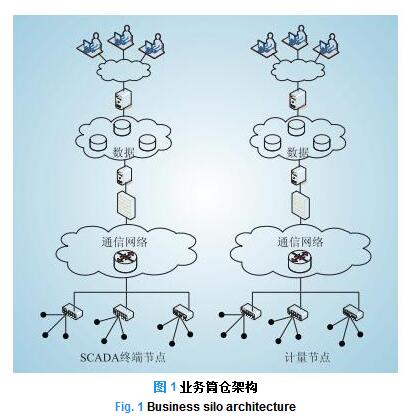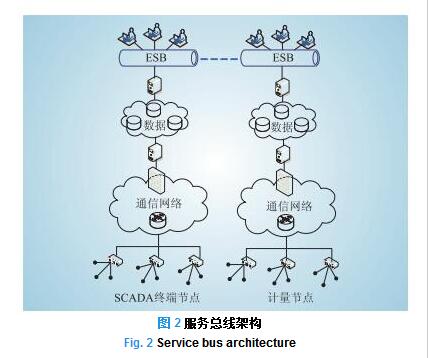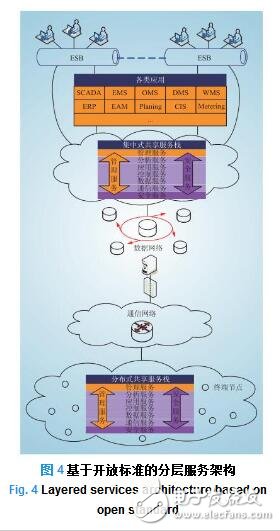introduction
With the urgent need for smart grids, countries are accelerating the deployment and promotion of smart grid construction. Many international organizations have released a series of smart grid architecture white papers, standards and roadmaps, and are still being improved and researched [1]. For example, the National Institute of Standards and Technology (NIST) has released the 1.0, 2.0 and 3.0 drafts of the Smart Grid Interoperability Framework and Roadmap, dividing the smart grid into seven areas, with an emphasis on interoperability. A series of standards, norms and guidelines have been proposed and a priority action plan has been developed; one of the core standards of the International Electrotechnical Commission (IEC) 57th Technical Committee (TC57), IECTR 62357, describes the reference architecture framework for smart grids. , including data models, services, protocols, and integration of all applications for future system integration [2-4].
China has also made certain contributions to smart grid standards. For example, the IEEE 1888 Working Group proposed a ubiquitous green community control network standard to achieve intelligent “energy creation, energy storage, and energy conservation†for the construction of an energy Internet; IEC PC118 Working Group Focus on the information exchange interface of the user-side system/device, and has formed the "Smart Grid User Interface Technical Specification" [5-6]. However, China has no relevant work on the smart grid architecture, and the State Grid Corporation has only proposed a strong standard framework for smart grids [7]. Based on the smart grid related standards, specifications, white papers and architectural framework proposed by many authoritative organizations, this paper describes the target principles of smart grid architecture and the evolution path of smart grid architecture based on the development route of IT architecture, and proposes to meet the future smart grid. A service-centric architectural vision of uncertain demand.
1 The principle of the smart grid architectureThe next 20 years will be a transitional phase from “traditional power grid†to “smart gridâ€, which will undergo long-term improvements and replacements [8]. The objectives of the smart grid architecture include: strong adaptability to new technologies, integration of new information and communication technologies with traditional power grids, ensuring efficient and stable operation of the system after adding new functional modules; control information and communication technology (ICT) system support The increasing complexity of grid intelligence; the new technology matches the strategic goals and development plans of the smart grid; the long-term solution is not only to achieve the vision of the smart grid, but also to meet uncertain business needs in the future; to support various interactions to ensure Interoperability to avoid information silos; the smart grid architecture is ultimately simple and transparent.
After identifying the goals of the smart grid architecture, a series of high-level design principles are needed to guide the architecture development work, based on smart grid vision and development trends, business needs, corporate capital and investment costs, decision making, etc., from design and development technicians, management From the perspective of personnel and users, and senior decision-making, the following principles of architecture development are proposed [8-11]:
(1) Simplify the system structure and create a measurement mechanism. Simplify the system structure by taking advantage of strategic assets, especially simplifying internal processes and greatly improving employee productivity. Key technology decisions are based on total cost of ownership, establishing measurable mechanisms for business performance and value, verifying whether the current ICT model is the best model, and maximizing the return on investment for ICT.
(2) Development closely surrounds the needs and brings convenience to subsequent development. Utilize business processes to transform development into “process-centricâ€, drive ICT development, and continuously improve its effectiveness and service efficiency; develop common data models, create a unified and easy-to-access data dictionary, and enable fast data exchange, integration and sharing, Reduce data conversion and improve operational efficiency; processes, data, services, and even ICT systems should be reusable to accelerate business delivery, reduce input costs, and make the system sustainable; in addition, applications should be portable It requires open standards and common data models and modeling methods to make programs independent of platform, location, and virtualization, and can quickly add, modify, delete, and replace services.
(3) Make full use of existing resources to avoid large-scale reconstruction. Maximize current system and equipment components, reduce low-value applications and introductions, and invoke high-value applications and reuse existing common services to reduce redundancy and development costs of infrastructure services, accelerate service market progress, and improve systems Interoperability to optimize the manageability of key businesses. This requires analysing how existing resources are integrated and designing business processes and solutions that leverage resources such as existing products or services.
(4) Pay attention to trusted data sources and develop data quality plans. The information supporting decision making must come from a trusted data source, which requires a clear determination of the trusted data source and a clear division of the scope of the business domain to which it is applied; creating a primary database in a trusted data source for easy retrieval by other programs Information to better ensure the integrity and reliability of information, while reducing the cost of data management; to develop a data quality plan for all businesses, to avoid interruptions or even decision-making errors due to data errors, to ensure good data quality.
2 Smart grid evolution routeThe future smart grid is based on an open standard, highly integrated centralized-distributed hybrid system with good interoperability and interoperability, and the development and evolution of the smart grid architecture will inevitably follow the development trend of IT architecture [12]. In the evolution process, the architecture mainly presents the following three stages.
2.1 Business silo stage
The silo stage can be described as a collection of different business silos, as shown in Figure 1. Each silo serves a single business unit with its own information system, and the tiny integration between silos keeps the grid running efficiently. However, this feature of the silo cannot meet the needs of intelligence. The independent silo structure of the business will not only consume a lot of time and cost, but also have high risks in the later integration and integration. Therefore, the interaction between silos is the main content of the first step of evolution.

With the emergence of new demands such as distributed energy access, in addition to the interaction between silos, the problem of interaction with new services must be solved. This requires the development and utilization of related parties and silos on the basis of existing business silos. The corresponding interfaces, in addition, these different interfaces need to evolve as the requirements evolve.
2.2 Bus partial integration phase
This phase is a standardization technology phase that integrates back-office, applications, and services primarily through the Enterprise Service Bus (ESB), as shown in Figure 2. Supported by open standards, ESB shares the application of business silos to the entire infrastructure, completes the good interaction between the systems and flexible calls of applications, and overcomes the problem of silo architecture information islands [13]. However, ESB integration requires strict implementation of open standards and data models, otherwise the ESB will only serve as a shared communication medium.

Although the ESB architecture is also an integrated architecture to a certain extent, it is not the target architecture of the final "integrated system". The underlying system still maintains a certain silo nature, and it is flexible in meeting future business needs and business development. There is still a big gap in terms of coupling.
2.3 Heterogeneous Network Convergence Phase
The heterogeneous network convergence phase focuses on the heterogeneous system convergence, integrates the business application system under the heterogeneous platform, and connects the heterogeneous systems, applications and data sources of various services inside and outside the enterprise through middleware such as adapters, thereby satisfying the internal application systems of the enterprise. The sharing of information, data and services, as shown in Figure 3.

The adapter architecture can support the continuous evolution of heterogeneous systems, which is mainly due to the interface conversion of the adapter, which formats and routes the messages and data of the heterogeneous network. However, the architecture is essentially based on message integration, but provides an intermediate communication solution for existing application systems. It is a network integration method that does not realize business modularization, service reusability, and standard unification. So it is not the ultimate target architecture of the smart grid, nor can it take advantage of the good opportunities offered by open Internet technologies.
In summary, the silo structure business will bring great difficulties to system integration and information interaction. In the evolution process, the first need to strengthen the interaction between business silos, through the bus integration application and background, to achieve business silos to preliminary Integrated transition; then, on the basis of partial integration, realize the integration of dedicated networks and data in related fields, and form an architecture that integrates heterogeneous networks by using middleware; then, on the basis of the foregoing, the architecture will transition to service-oriented and realize business modularization. .
3 Future Smart Grid ArchitectureTo build a smart grid system with strong adaptability and robustness, a flexible architecture is needed as a support [14]. Service-centric integration is the most effective way to integrate highly heterogeneous, distributed systems and applications. Therefore, the service-centric architecture is the development goal of the future IT architecture and the development trend of the future smart grid architecture.
The layered service architecture based on open standards continues the middleware integration of ESB integration and adapter architecture of enterprise service bus, modularizes service and service through open standards, takes service as the center, and combines the characteristics of network system and business needs. The service classification is layered to form a layered architecture that combines the centralized shared service stack with the distributed shared service stack, as shown in Figure 4. This architecture satisfies the main features of the "system of the system". The whole system consists of multiple independent distributed systems. The independence is that the operation and management of the member systems are independent of each other, and the association is that the member systems need to cooperate with each other to implement system functions. This kind of synergy is only a temporary sudden behavior [15-16].

The architecture is service-oriented, breaking down each application function into a service that is accessible. These services have the independence of protocol and technology. Each service does not need to care about the physical location and implementation technology of other services, and can be invoked through different protocols. The services are connected and integrated in a loosely coupled manner, and the service is increased or decreased. And modifications will not affect other services. Combining services in different ways creates different business processes and enables different functions. When a business process changes, generally only need to modify the service combination mode; when there are new business requirements, simply design the corresponding service according to the business requirements, and join the service stack, through the combination with other services. New business needs. The loose coupling and reusability of the service reduces the need for the underlying programming development of the system, enabling the system to achieve higher quality development applications in a more flexible manner.
The interfaces in this architecture are defined consistently based on open standards, making the service description easy to understand and guaranteeing the reusability of the service; this interface is not mandatoryly bound to specific functions, and can shield the implementation technology and physical location; The interface of the service is unchanged, and changes in the service provider and user do not affect each other, thus minimizing the impact of changes.
The layered service architecture based on open standards supports the evolution path mentioned above, and it also has the advantage that existing system function applications can be integrated as services to protect existing infrastructure investments. In the initial stage of architecture construction, we first consider starting from the current important integration requirements, packaging existing systems and applications, and developing necessary new services to provide the basis for subsequent integration. With more and more integrated services, ultimately, Some of the new integration requirements will be implemented through existing services, and the integration of the entire system will gradually expand in a gradual manner. Due to the loose coupling and flexibility brought by open standards, existing systems migrate to new technology platforms or be replaced without affecting related functional applications, which makes the whole system highly adaptable and robust.
4 Conclusion
Based on the future demand and development trend of smart grid, this paper proposes the framework objectives and principles, and focuses on achieving the maximum investment benefit and optimal architecture development based on reducing investment costs and implementing complex smart grid architecture, emphasizing the existing grid resources. Integrate utilization and reusability of programs and services, and manageability of the system. The evolution route of smart grids in different stages is proposed, which realizes the transition of the grid from the business silo stage to the utilization of the standardization stage to the heterogeneous network integration stage, so that the grid structure gradually transitions to the future target architecture goal, avoiding the reconstruction of the power grid system. And a large number of equipment replacements, to maximize the protection of existing construction investment, reduce the transition cost; put forward the idea of ​​the future smart grid architecture, the future smart grid architecture should be based on open standards of hierarchical service architecture, this architecture is sufficient Combining the advantages of Internet technology, the system is transformed into service-oriented and business modularization. The services and interfaces based on open standards make the architecture very flexible, and at the same time make the service highly reusable and loosely coupled. The system is highly adaptable and robust in the face of new business joins and business turnover.
Electrical Polyester Nonwoven Fabric
Electrical Polyester Nonwoven Fabric,Polyester Nonwoven Fabric,Polyester Spunbond Nonwoven Fabric,Spunbond Polyester Fabric
Longkou Libo Insulating Material Co.,Ltd. , https://www.liboinsulation.com
